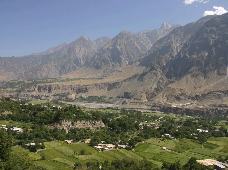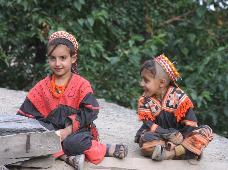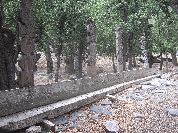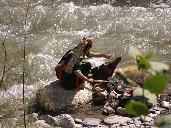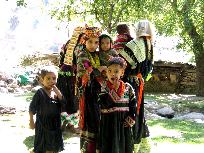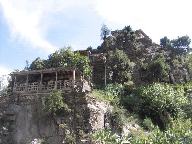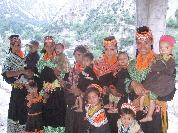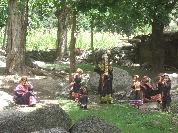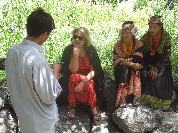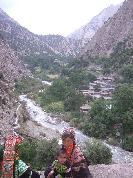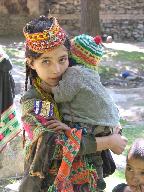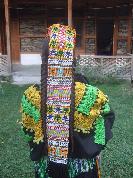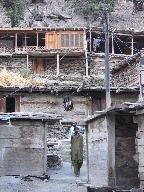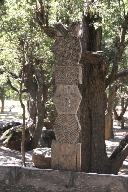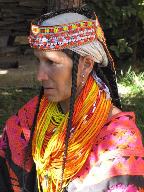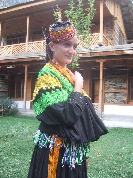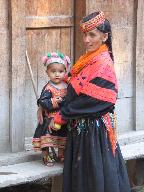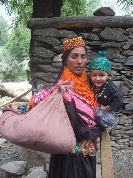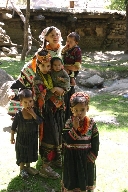Jeep Tour K2 Trek Snow Capped High Mountains Valley Travel
|
Kalash The Kalash live in the high pastures of the Hindu Kush flanking the Chitral The
non-Muslim Kalash have a culture very drastically from the all the ethnic
groups that surround them; nature plays a central role in their daily and
spiritual life. As part of their religious tradition, sacrifices are offered
and festivals held to give thanks for the abundant resources of their three
valleys. Kalash mythology and folklore has been compared to that of ancient Whilst
historically the Kalash may have lived across large swathes of NW Pakistan
and KJTI’s
tour takes in Brum, which is the main
village in the Rombir valley. Entry to the valley is through a very narrow and
precipitous jeep track but when you will be glad you survived it, as our
twenty year relationship with the people of this village will mean that you
will be made to feel part of everyday life. You will enjoy a traditional
Kalash meal and an early night in a simple cabin in the middle of the
village. You may also meet our old
friend, the venerable Saifullah Jan the chief of the three valleys. KJTI tourist’s quotes: “What really makes the Kalash stand out is their liberal
attitude to women and the colourful clothes that the women and girls wear.
They usually wear black dresses covered by incredibly colourful beaded
necklaces and headdresses. The drab black and brown was the traditional wear
till much cheaper colourful materials and beads became available at the end
of the 19th century and the Kalash adopted this with gusto. The
colourful dresses are in no way just put on for tourists, this is genuinely
the every-day wear; doesn’t make them any less photogenic though. Obviously
they wanted to sell us some handicrafts. These were absolutely lovely and much
time and effort had gone into their making.
We were the only tourists here. They are extremely friendly and although our guest house
was quite basic it was the best accommodation they had in the village and we
genuinely considered it an honour and a privilege to be able to stay there. We realised that it didn’t do to enquire too carefully
how/where the cooking pots were washed or where the water for cooking came
from, but we always felt we were given the best they had, and we
never got ill – a mantra it is well worth repeating. Both mornings we
were there we had honey for breakfast – not the refined and centrifuged
stuff, but honey freshly collected from a nest up a tree, in the mountains
and complete with honey comb and ‘bits’. The Kalash attitude to agriculture
other than the growing of wheat or maize is interesting. They just pick and
eat where it grows. They don’t
cultivate. In this way we ate our fill
of very fresh walnuts, grapes, mulberries and apricots – they just don’t
actually cultivate them in the way we would understand the term. In summer,
some of the men take the herds of goats high up into the mountains. Goats are
most useful as they are a source of wool, meat, milk and cheese and they will
eat anything. We were taken on a tour of the village which involved
going up to one of the male temples. Kalash beliefs are interesting –
everything is either ‘pure’ or ‘impure’. Men are ‘pure’, women are ‘impure’.
Each has their own roles and responsibilities, fields to tend and jobs, and
the two do not mix. Likewise, there are ‘male’ temples and ‘female’ temples.”
This place is a stunningly picturesque village of about 60
stone and wood houses on a small stream that in turn flows into the main
river of the valley. The stream itself is used for everything – washing
self/clothes/pots, drinking water for goats and sheep and water for cooking;
it even flows under our guesthouse. The guesthouse has been relatively
recently built by the chief of the village.
BBC News | In pictures Kalash spring festival Adventure Travel in North |
||
|
Click any image to enlarge |
||
|
|
|
|
